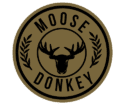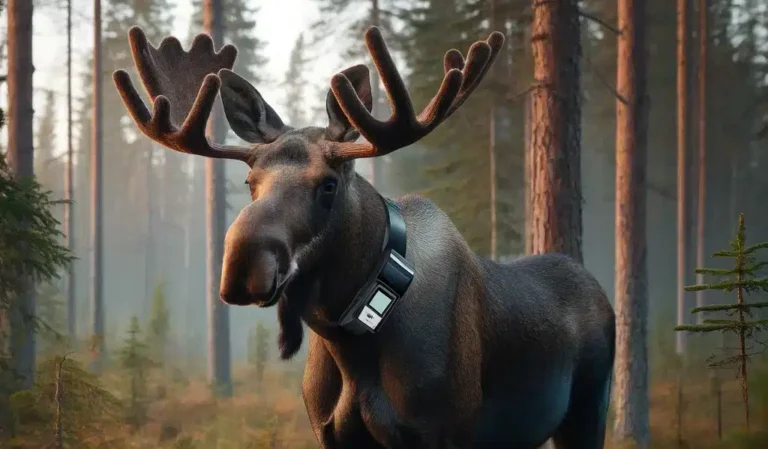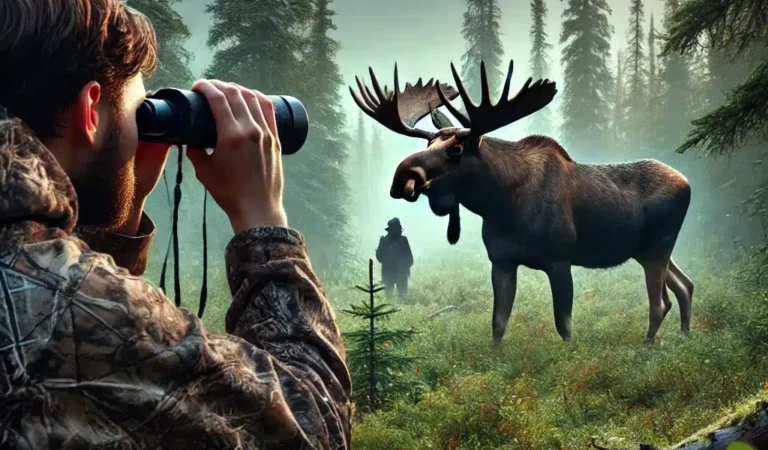Picture this: You’re knee-deep in a misty Alaskan marsh at dawn, when suddenly you hear it – the deep, guttural grunt of a mature bull moose. Your heart races as you realize this could be the moment you’ve spent months planning for. Then you catch a glimpse of the Alaska moose.
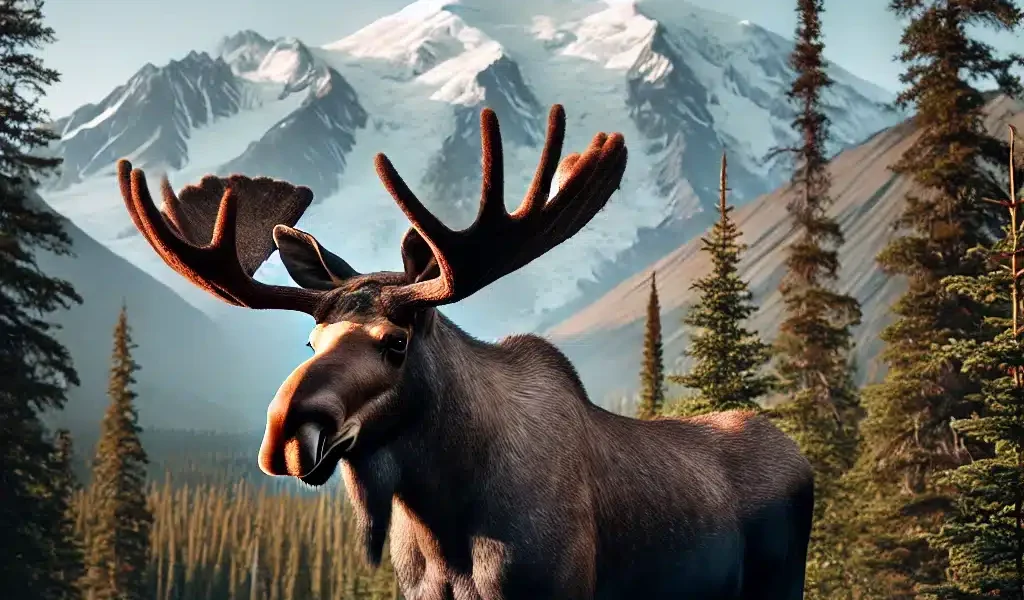
Let’s cut straight to the chase, fellow hunters. If you’re reading this, you’re probably dreaming about taking down one of North America’s most impressive game animals – the Alaska-Yukon moose. These aren’t just any moose we’re talking about. These are the giants that make lower-48 moose look like yearlings.
I’ve spent 15 seasons tracking these magnificent beasts across Alaska’s wilderness, and I’ve learned something about what works and what’ll send you home with nothing but soggy boots and empty tags.
The Alaska moose population might be healthy, but that doesn’t make hunting them any easier. Whether you’re planning your first hunt or a seasoned veteran looking to up your game, I’m about to share the practical advice I wish someone had given me when I started.
Trust me, the difference between success and failure often comes down to understanding a few key things about these animals and the challenging terrain they call home. So grab your coffee, and let’s dive into what you need to know about hunting the mighty Alaska moose.
Understanding the Alaska Moose: The Giants of the North

Size Isn’t Just a Number
Let’s be real – until you’re standing next to an Alaska-Yukon moose, it’s hard to grasp just how massive these animals are. We’re talking about bulls that stand 7 feet tall at the shoulder and cows that could make a lower-48 bull look small.
That 1,600-pound weight I mentioned? That’s about the same as a compact car, and when you’re quartering one out in the backcountry, you’ll feel every pound of it.
The Alaska Moose Population: By the Numbers
- Estimated 175,000-200,000 moose statewide
- Highest densities in Interior and Southcentral regions
- An average of 7,000 are harvested annually
- Success rates hover around 30% for guided hunts
Reading the Land: Where the Giants Live
River Systems
- Focus on braided river systems with plenty of willows
- Look for areas with 3-15 year old burn zones
- Key in on south-facing slopes in the early season
- Watch for areas where multiple drainages meet
Feeding Patterns
These aren’t your garden-variety browsers. Alaska moose have specific feeding patterns:
- Early Morning: Active feeding in open areas
- Mid-Day: Bedded in thick cover near food
- Evening: Return to open areas for feeding
- Seasonal Changes: Moving from highlands to valleys as snow deepens
Bull Behavior
Understanding bull behavior is crucial for a successful hunt:
- Pre-Rut (Late August): Bulls are still bachelor groups
- Early Rut (Early September): Starting to separate
- Peak Rut (Mid-September): Aggressive and vocal
- Post-Rut: More cautious and harder to pattern
Signs to Watch For
Fresh sign tells you everything:
- Tracks: Bulls leave prints over 6 inches long
- Rubs: Look for stripped bark on trees 6-8 feet high
- Droppings: Fresh droppings mean active feeding areas
- Antler Marks: Torn-up brush and scarred trees
The Alaska-Yukon Moose Advantage
What makes these northern giants different:
- Larger body size means more meat (600+ pounds per bull)
- Bigger antler spread (average 60+ inches)
- More aggressive rut behavior
- Different calling strategies are needed
- Underestimating size when field judging
- Not being ready for the meat pack out
- Hunting only one spot instead of staying mobile
- Calling too much in the early season
- Not being prepared for extreme weather changes
The Hunt: Timing is Everything – Breaking Down the Season
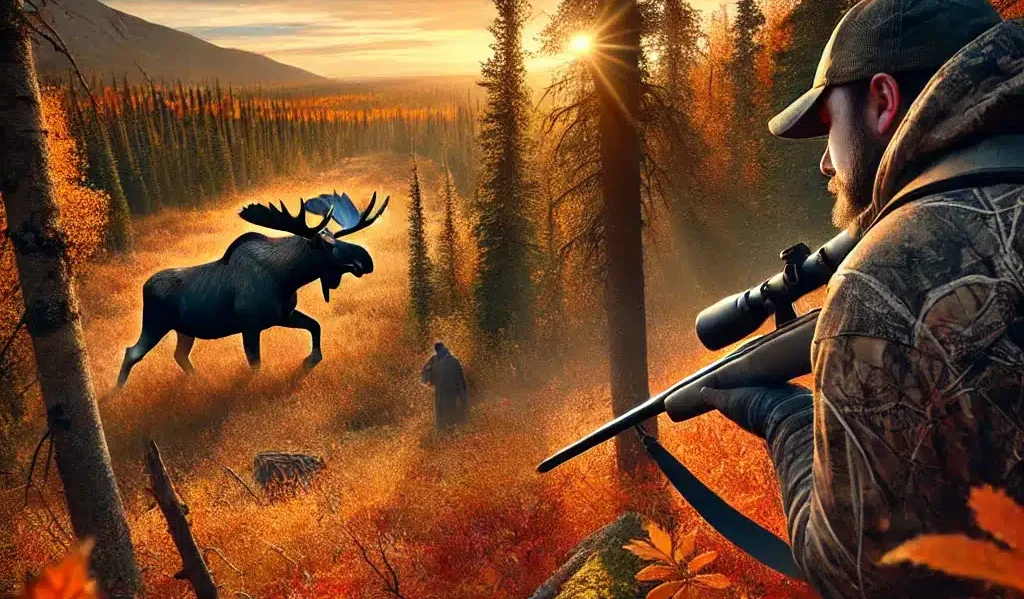
Pre-Season Planning
Before you even think about pulling the trigger:
- Scout your unit in July/August if possible
- Check historical harvest data on the ADF&G website
- Line up your meat processing plan
- Get your gear dialed in and tested
Alaska Moose Hunting Season Breakdown
Early Season (September 1-14)
- Bulls still in summer patterns
- Focus on willow flats and high basins
- Best for spot-and-stalk hunting
- Warmer temps mean faster meat spoilage
Peak Rut (September 15-25)
- Prime calling period
- Bulls actively searching for cows
- Most aggressive response to calls
- Highest success rates
Late Season (September 26-30)
- Bulls getting cautious
- May need to cover more ground
- Weather typically deteriorating
- Fewer hunters in the field
Weather Factors The reality of hunting the Last Frontier:
- Early season can hit 70°F
- Late season can drop below freezing
- Rain gear is mandatory
- Plan for snow above 2,000 feet
Daily Time Management

Here’s how to structure your hunting day
Morning (First Light – 10 AM)
- Be in position before sunrise
- Glass feeding areas
- Set up near travel corridors
- Listen for calling bulls
Midday (10 AM – 4 PM)
- Still-hunt through bedding areas
- Glass from elevated positions
- Track and follow fresh sign
- Stay ready (bulls can appear anytime)
Evening (4 PM – Dark)
- Return to morning locations
- Increase calling frequency
- Watch wind direction carefully
- Prepare for low-light shots
Calling Strategies by Time Period
Early Season
- Soft cow calls only
- Minimal calling
- Focus on location calls
- Wait 30+ minutes between sequences
Peak Rut
- Aggressive bull grunts
- Challenge calls
- Cow calls every 15-20 minutes
- Add brush thrashing
Unit-Specific Timing
Popular units and their prime times:
- Unit 20A: September 15-25
- Unit 13: September 1-20
- Unit 16B: September 15-25
- Kenai Peninsula: September 1-20
Getting Legal – The Paperwork You Need

License Requirements Resident Hunters
- Basic hunting license: $45
- Metal locking tags
- Harvest tickets
- Hunter education certification
Non-Resident Requirements
- Hunting license: $160
- Guide contract (required in most units)
- Proof of hunter education
- Special area permits
Gear That Matters – The Real Equipment
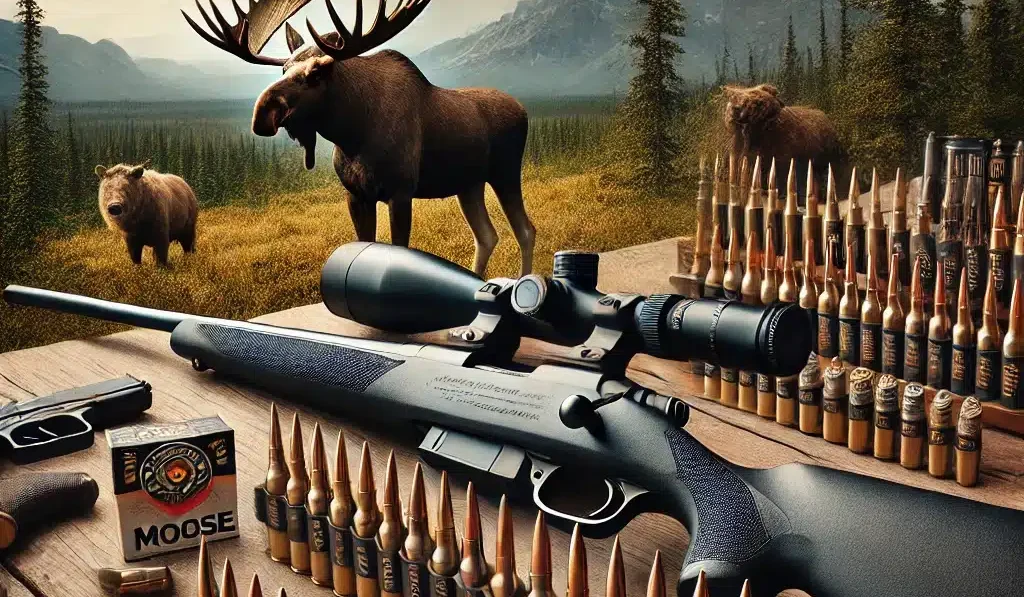
Optics ($500-2,000 Investment)
- Binoculars: 10×42 minimum (Vortex, Leupold)
- Rangefinder: 1,000-yard minimum
- Spotting scope: Optional but valuable
Weapons and Ammo Rifles
- Minimum .30-06 (bigger is better)
- Popular choices: .338 Win Mag, .375 H&H
- Backup iron sights
- Quality scope mount
Ammo
- Premium bullets (200+ grains)
- 40 practice rounds
- 20 hunting rounds
- Keep ammo dry!
Navigation Gear ($300-700) Must-Haves:
- GPS with Alaska topo maps
- Satellite communication device
- Backup compass
- Physical maps of your unit
Calling Equipment ($50-150)
- Fiberglass bull tube
- Paddle call
- Cow call
- Practice BEFORE the hunt
Field Care Equipment ($200-400)
- Heavy-duty game bags (6 minimum)
- Paracord (100 feet)
- Sharp knife set
- Bone saw
- Rubber gloves
- Meat hauling frame
Field Strategies That Work
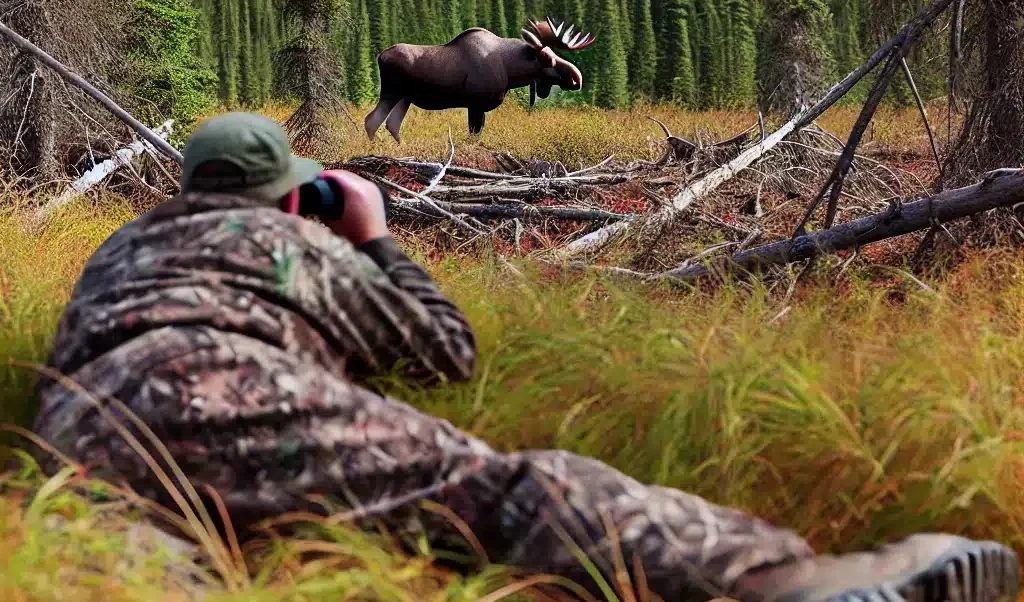
Spotting and Stalking Reading the Terrain
- Glass from high points
- Scan darker timber edges
- Watch for ear flicks or antler glints
- Use terrain features for approach
Wind Management
- Always hunt into the wind
- Carry wind checker powder
- Plan multiple approach routes
- Be patient with the final approach
Calling Techniques That Work The Setup
- Position 100 yards from the thick cover
- Set up with shooting lanes identified
- Face downwind
- Have a clear escape route
Basic Calling Sequence
- Soft Cow called to locate
- Wait 15 minutes
- Bull grunt if there is no response
- Add brush thrashing
- Wait 30 minutes before moving
Shot Placement Vital Zones
- Behind the shoulder, 1/3 up from the bottom
- Quartering away: Aim for the opposite shoulder
- Avoid frontal shots
- Wait for a clear broadside when possible
After the Shot
- Wait 30 minutes unless you see it drop
- Mark your shooting position
- Take photos before field dressing
- Start thinking about meat care
Field Care and Meat Handling
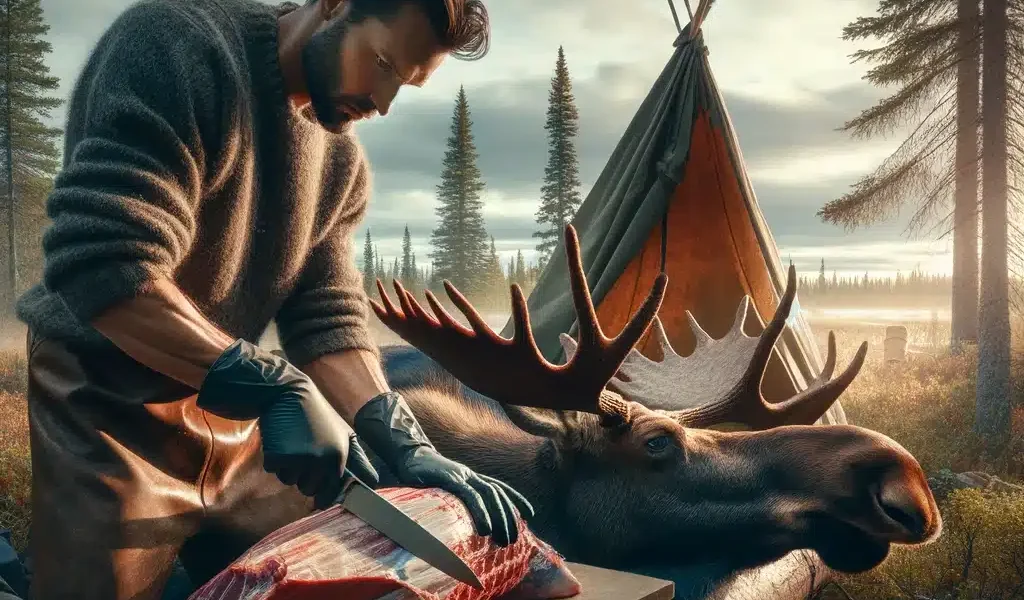
The Clock is Ticking
- 3-hour window to get meat cooling
- Quarter immediately
- Keep meat clean and dry
- Get game bags up off ground
Quartering Process
- Photos first
- Gut immediately
- Remove quarters
- Split backbone
- Pack in game bags
- Get on meat poles
Field Judging Alaska Moose – Don’t Blow Your Opportunity

Size Assessment Palm Width
- Legal bull needs a 50-inch spread OR
- Four brow tines on one side OR
- Three brow tines on both sides
- Use your rifle scope width as reference (typically 4 inches)
Quick Field Guide
- Ears are 26 inches tip to tip when alert
- If antlers extend 2+ ear-widths per side, likely legal
- Palms should look like opened newspapers
- Watch for heavy paddles and deep cups
Common Judging Mistakes
- Not accounting for distance
- Rushing the assessment
- Getting excited over the first bull
- Poor angle evaluation
Advanced Hunting Tactics

Calling Scenarios When He’s Coming
- Stay dead still
- Call softer as he approaches
- Stop calling under 100 yards
- Be ready for a quick appearance
When He Hangs Up
- Try cow call from a different angle
- Add brush-breaking sounds
- Wait him out (30+ minutes)
- Consider circling downwind
Reading Bull Body Language
- Hair raised: He’s fired up
- Ears back: Likely to charge
- Slow walk: Still suspicious
- Head high: Looking for a cow
Pack Out Strategy – The Real Work Begins
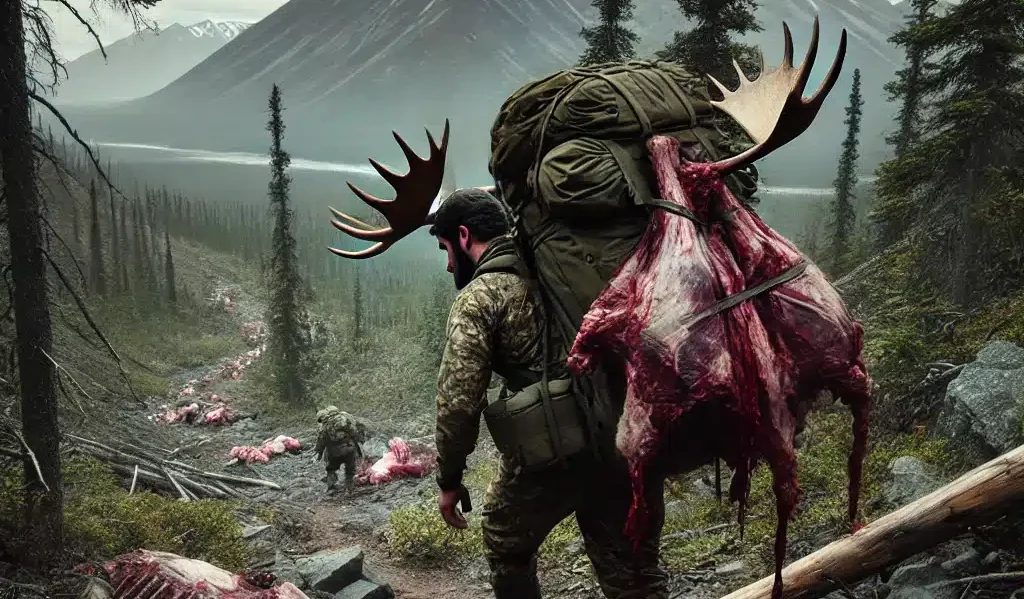
First Steps
- Take lots of photos
- Tag immediately
- Start skinning while the meat is warm
- Get on satellite phone for help if needed
Meat Care Priorities
- Hindquarters (heaviest/most meat)
- Front shoulders
- Backstraps and neck meat
- Rib meat and trim
- Head/antlers last
Pack Out Tips
- 140-180 pounds per load
- Rest every 45 minutes
- Hydrate constantly
- Use game poles on steep terrain
Conclusion – Final Thoughts from the Field

Success Factors
- Physical preparation is crucial
- Mental toughness matters more
- Patience kills more bulls than skill
- Always have a backup plan
Resources Worth Having
- Alaska hunting regulations app
- Local processors’ numbers
- Emergency contacts
- Unit maps downloaded offline
Remember
- Success rates hover around 30%
- Most fails to happen after the shot
- The work starts when the trigger is pulled
- There is no shame in asking for help
If you’re heading into Alaska moose country, clip this to your planning board: Nobody ever regretted being over-prepared. Your hunt might last 10 days, but you’ll remember every minute for the rest of your life.
Frequently Asked Questions About Alaska Moose
Q: How many moose are in Alaska?
According to recent Alaska Department of Fish & Game estimates, Alaska has approximately 175,000-200,000 moose. The population varies by region and year, with the highest densities in Southcentral and Interior Alaska. These numbers fluctuate based on:
- Winter severity
- Predator populations
- Hunting pressure
- Habitat quality
- Disease outbreaks
Q: What’s the best time to see moose in Alaska?
While moose can be spotted year-round in Alaska, certain times offer better viewing opportunities:
- September (Peak): Rutting season means the most active behavior
- Early Morning/Evening: Best daily viewing times
- May-June: Cows with new calves
- Winter: Easier spotting against snow
- Dawn/Dusk: Prime feeding times
Best Viewing Locations:
- Denali National Park
- Anchorage’s Coastal Trail
- Kenai Peninsula
- Chugach State Park
- Mat-Su Valley
Q: What’s the success rate for Alaska moose hunters?
Overall success rates average 25-30%, with variations by:
- Guided vs unguided hunts
- Area/unit selection
- Hunter experience
- Transportation method
- Season timing
Q: How much meat can I expect from an Alaska moose?
An average bull yields:
- 350-500 pounds of boned meat
- 600+ pounds if quarters aren’t boned
- Approximately 40% of live weight
- Enough to fill 2-3 chest freezers
Q: Do I need a guide for moose hunting in Alaska?
Guide requirements depend on residency:
- Alaska Residents: No guide required
- Non-residents: Guide required in most units
- Military stationed in AK: Considered residents
- Non-resident aliens: Guide always required
Q: What’s the minimum legal equipment for moose hunting?
Legal equipment requirements include:
- Minimum caliber: .243 (larger recommended)
- Fixed-blade broadheads for bow
- 50-pound minimum draw weight for bow
- No full-metal jacket bullets
